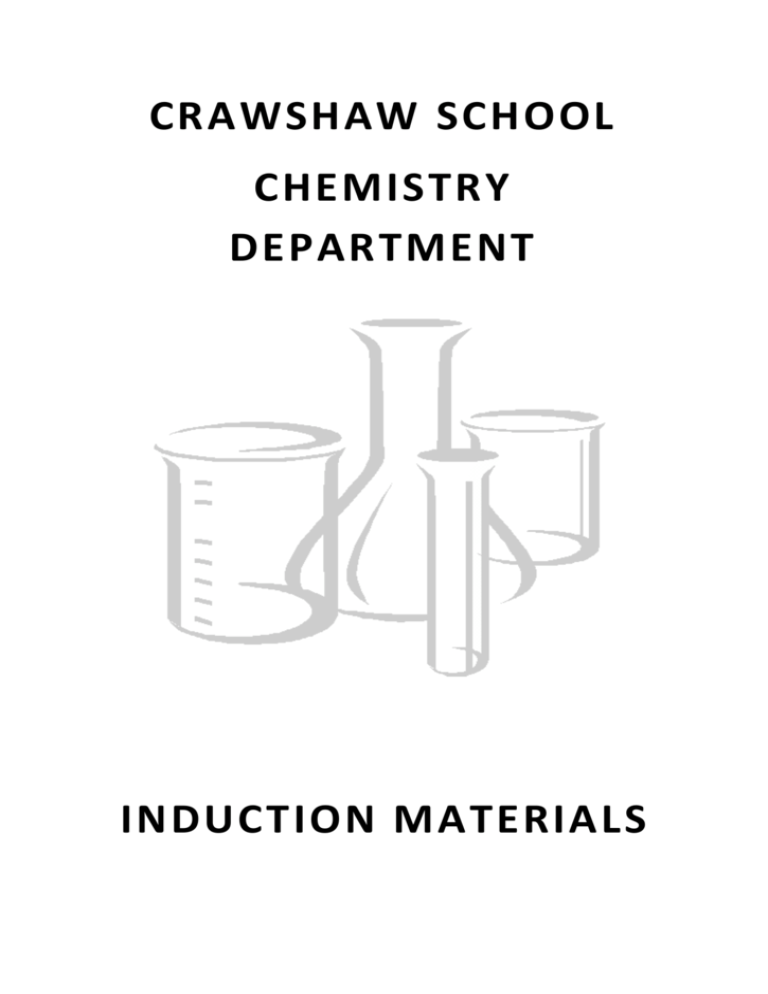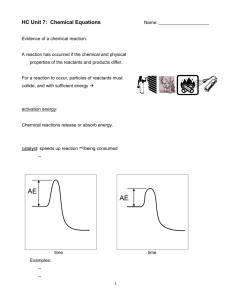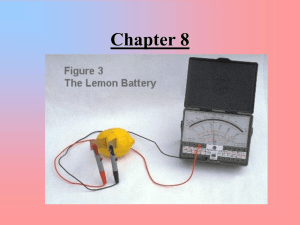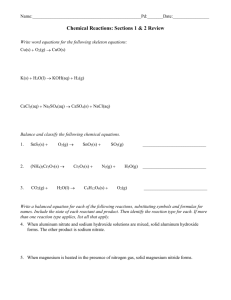OCR Chemistry
advertisement

CRAWSHAW SCHOOL CHEMISTRY DEPARTMENT INDUCTION MATERIALS WELCOME TO AS CHEMISTRY @ CRAWSHAW! This information aims to provide you with: Basic information about the course How you can prepare for a successful start to your AS Chemistry Other relevant information about the course OCR Chemistry At CRAWSHAW we follow the OCR AS-level course, which has the following structure: Unit F321: Atoms, Bonds and Groups Atoms and reactions Electrons, bonding and structure The Periodic Table 30% AS level assessed by a 1hr written paper of 60 marks Unit F322: Chains, Energy and Resources Basic concepts and hydrocarbons Alcohols, halogenoalkanes and analysis Energy Green Resources 50% As level assessed by a 2 hr written paper of 100 marks Unit F323: Practical Skills in Chemistry 1 This AS (practical skills) unit is teacher assessed and externally moderated by OCR. Candidates are assessed on one task from each of the following categories: qualitative, quantitative and evaluative tasks. This controlled assessment component is integrated into the teaching of the modules 20% of AS level assessed throughout year, 40 marks Preparation for AS Chemistry AS Chemistry is an academically demanding course. Prospective students should be comfortable with the basic Chemistry from the GCSE course, most significantly: ‘Bonding and Structure’, ‘Periodicity’, ‘Chemical Formulae’, Chemistry Calculations’ and ‘Balancing Equations’. In order for you to settle into the course quickly it is essential that you do some background work on these topics, particularly if you are starting the course with a B in Science/Additional Science. A good place to start with your preparation for the course would be reviewing your GCSE notes or GCSE revision guide or textbook then completing the induction materials provided. You must complete these exercises and hand them in to your Chemistry teacher in the first week of the course. You will have a test after the second week of the course on the material covered in these induction materials. CGP also produce a guide which aims to bridge the gap between GCSE and A-Level called ‘Head Start to AS Chemistry’ During the first few weeks of the course the teaching staff will carefully monitor your progress and offer support and advice where necessary. Above all, you must be honest with yourself and undertake additional reading as and when it is required. The websites listed below will be of some help: WEBSITE www.gcsechemistry.co.uk http://www.wfu.edu/~ylwong/balanceeq/balanc eq.html http://misterguch.brinkster.net/eqnbalance.html www.bbc.co.uk/schools/gcsebitesize/chemistry www.wpbschoolhouse.btinternet.co.uk www.webelements.com http://www.chemsoc.org/viselements/ www.theodoregray.com www.s-cool.co.uk www.chemguide.co.uk http://www.chemistrygeek.com http://antoine.frostburg.edu/chem/senese/101/in dex.shtml GCSE REVISION A LEVEL Some good free resources Tutorials on chemical formulae and balancing equations – essential basics for AS Level Students Good basic material Excellent revision material for all levels ‘Dr Brown’s site’ Useful sources of information on each of the elements. Nice videos of explosions etc. Excellent revision source for both GCSE and ALevel. The best A-Level site Interactive stuff Useful glossary + FAQ’s Mathematical requirements In order to be able to develop their skills, knowledge and understanding in chemistry, students need to have been taught, and to have acquired competence in, the appropriate areas of mathematics relevant to the subject as indicated below. Arithmetic and numerical computation: (a) recognise and use expressions in decimal and standard form; (b) use ratios, fractions and percentages; (c) make estimates of the results of calculations (without using a calculator); (d) use calculators to find and use power, exponential and logarithmic functions. Handling data: (a) use an appropriate number of significant figures; (b) find arithmetic means. Algebra: (a) change the subject of an equation; (b) substitute numerical values into algebraic equations using appropriate units for physical quantities; (c) solve simple algebraic equations; (d) use logarithms in relation to quantities which range over several orders of magnitude. Graphs: (a) translate information between graphical, numerical and algebraic forms; (b) plot two variables from experimental or other data; (c) understand that y = mx + c represents a linear relationship; (d) determine the slope and intercept of a linear graph; (e) calculate rate of change from a graph showing a linear relationship; (f) draw and use the slope of a tangent to a curve as a measure of rate of change. Geometry and trigonometry: a) appreciate angles and shapes in regular 2-D and 3-D structures; b) visualise and represent 2-D and 3-D forms including two-dimensional representations of 3-D objects; c) understand the symmetry of 2-D and 3-D shapes. Other information Equipment – Work done in lessons is usually written on A4 lined paper, so a lever-arch file to store work from both your Chemistry teachers is essential. A scientific calculator is also required. Text Books – These are issued to all students for the duration of the course and must be returned at the end of each academic year. Should a student leave the course for any reason agreed with Mrs Pheasey the textbook must be returned or paid for. Chemistry staff @ Crawshaw – Students will be taught by both Mrs Dhesi Assistant Head (dhesipk01@leedslearnng.net) and Miss Dale Head of science (dalec01@leedslearning.net ) INDUCTION MATERIALS The following worksheets must be completed and handed in after the summer holiday to your Chemistry teachers: 1. 2. 3. 4. 5. 6. Basic atomic structure Reaction types Ionic substances Balancing equations Formula Mass Reacting mass calculations Basic atomic structure 1) a) What three particles are atoms made from? (3) b) Which particles are in the nucleus? (2) c) Explain why atoms are neutral even though they contain positive and negative particles. (2) 2) a) Define the atomic (or proton) number of an atom. (1) b) Define the mass number of an atom. (1) c) Using the mass number and atomic number of an atom: 3) i) How do you work out the number of neutrons in an atom? (1) ii) How do you work out the number of electrons in an atom? (1) iii) How do you work out the number of protons in an atom? (1) Complete the table below about the structure of atoms. Atom Atomic Mass number number 9 19 No. of protons No.of neutrons No. of electrons (21) Electron structure 40 Ar 27 18 Al 13 4 5 17 1 18 0 4) a) What are isotopes? b) Explain why isotopes have the same chemical properties. (2) (2) Reaction types For each of the following reactions, give the reaction type. 1) copper + oxygen copper oxide 2) lead oxide + hydrogen lead + water 3) nitrogen + hydrogen ammonia 4) lead carbonate + hydrochloric acid lead chloride + carbon dioxide + water 5) lead oxide + carbon lead + carbon dioxide 6) lead carbonate lead oxide + carbon dioxide 7) nitric acid + sodium oxide sodium nitrate + water For each of the following reactions, write a word equation and then give the reaction type. 8) When zinc carbonate is heated, zinc oxide and carbon dioxide are formed. 9) When calcium is burned, calcium oxide is formed. 10) When electricity is passed through a molten lead bromide, lead and bromine are formed. 11) When copper oxide is heated with hydrogen, copper and steam are formed. 12) When sulphuric acid is mixed with sodium hydroxide, sodium sulphate and water are formed. 13) When chlorine is passed through a solution of potassium bromide, bromine and potassium chloride are formed. 14) When light shines on silver chloride, silver and chlorine are formed. 15) When nickel is heated in air, nickel oxide is formed, although the nickel does not burn. Ionic substances 1) a) Explain why ionic substances have high melting and boiling points. (2) b) Explain why ionic substances can conduct electricity when melted or dissolved. c) Explain why ionic substances cannot conduct electricity when solid. 2) The diagram shows the ions in solid sodium chloride. Re-draw the diagram to show how the ions would be arranged if the sodium chloride was melted. (2) (2) - Cl ion Na+ ion (2) 3) 4) Write the formula of the following ionic compounds. a) calcium chloride d) aluminium hydroxide b) sodium oxide e) potassium carbonate c) magnesium sulphide f) calcium nitrate (6) Complete the passage below using the following words: loses ions ionic protons negative electrons positive gains Atoms are neutral because they have the same number of ………………….. and ………………… . If atoms lose or gain electrons they become electrically charged and are called ………… (they are not atoms any more). If atoms gain electrons they become ……………….... ions, and if they lose electrons they become ………………… ions. When a metal reacts with a non-metal, the metal atoms …………….. electrons and the non-metal atoms …………… electrons, forming an ……………….. compound. (8) 5) a) Complete the table about the metals below (answer on the sheet). Element Na K Mg Ca (10) Al Group number Number of electrons in outer shell Number of electrons needed to lose to get full outer shell Number of electrons needed to gain to get full outer shell Charge on the ion it forms b) What do you notice about the Group number and the charge on the ions for metals? (1) 6) a) Complete the table about the non-metals below (answer on the sheet).(10) Element Cl Br I O S Group number Number of electrons in outer shell Number of electrons needed to lose to get full outer shell Number of electrons needed to gain to get full outer shell Charge on the ion it forms b) What do you notice about the Group number and the charge on the ions for non-metals? (1) 7) a) What is the electron configuration of the following ions? i) Na+ ii) Ca2+ iii) S2- iv) F- (4) b) What do you think would be the charge on ions formed from the following elements? i) strontium (Sr) ii) tin (Sn) iii) astatine (At) (3) Balancing equations 1) Ca + H2O Ca(OH)2 + H2 2) CO + O2 CO2 3) Ca + O2 CaO 4) Fe2O3 + HCl FeCl3 + H2O 5) NH3 + H2SO4 (NH4)2SO4 6) Al + H2SO4 Al2(SO4)3 + H2 7) CaO + HCl CaCl2 + H2O 8) NH3 + O2 NO + H2O 9) Na2O + H2O NaOH 10) Na2CO3 + HCl NaCl + CO2 + H2O 11) Br2 + KI KBr + I2 12) Ca(OH)2 + HNO3 Ca(NO3)2 + H2O 13) Fe + H2O Fe3O4 + H2 14) Pb3O4 + HNO3 Pb(NO3)2 + PbO2 + H2O 15) Cu + HNO3 Cu(NO3)2 + H2O + NO 16) HNO3 NO2 + H2O + O2 Formula Mass 1) Calculate the relative molecular mass (Mr) of: 2) 3) 4) a) H2 g) Ca(OH)2 b) Ne h) K2SO4 c) NH3 i) NH4NO3 d) CH4 j) Ca(NO3)2 e) MgBr2 k) Al2(SO4)3 f) S8 l) H2C2O4.2H2O (12) Calculate the percentage by mass of the elements shown in the following compounds (you have worked out the Mr's of (a) to (g) in question 1). a) C in CH4 e) N in Ca(NO3)2 b) Br in MgBr2 f) O in Ca(NO3)2 c) S in K2SO4 g) O in Ca(OH)2 d) N in NH4NO3 h) O in Fe(NO3)3 (9) Calculate the relative molecular mass (Mr) of: a) sodium oxide c) copper hydroxide b) calcium carbonate d) zinc nitrate (8) Calculate the percentage by mass of the elements shown in the following compounds. a) Cl in calcium chloride b) O in iron (III) oxide (6) Reacting mass calculations 1) What mass of hydrogen is produced when 192 g of magnesium is reacted with hydrochloric acid? Mg + 2 HCl MgCl2 + H2 2) What mass of oxygen is needed to react with 8.5 g of hydrogen sulphide (H2S)? 2 H2S + 3 O2 2 SO2 + 2 H2O 3) (3) What mass of oxygen is required to oxidise 10 g of ammonia to NO? 4 NH3 + 5 O2 4 NO + 6 H2O 6) (3) Railway lines are welded together by the Thermitt reaction, which produces molten iron. What mass of iron is formed from 1 kg of iron oxide? Fe2O3 + 2 Al 2 Fe + Al2O3 5) (3) What mass of potassium oxide is formed when 7.8 g of potassium is burned in oxygen? 4 K + O2 2 K2O 4) (3) (3) What mass of aluminium oxide is produced when 135 g of aluminium is burned in oxygen? 2 Al + 3 O2 Al2O3 (3) 7) What mass of iodine is produced when 7.1 g of chlorine reacts with excess potassium iodide? Cl2 + 2 KI 2 KCl + I2 8) What mass of hydrogen is needed to react with 32 g of copper oxide? CuO + H2 Cu + H2O 9) (3) What mass of magnesium oxide is formed when 6 g of magnesium reacts with oxygen? 2 Mg + O2 2 MgO 13) (3) How much calcium oxide is produced by heating 50 g of calcium carbonate? CaCO3 CaO + CO2 12) (3) What mass of hydrogen is produced when 195 mg of potassium is added to water? 2 K + 2 H2O 2 KOH + H2 11) (3) What mass of oxygen is formed when 735 g of potassium chlorate decomposes? 2 KClO3 2 KCl + 3 O2 10) (3) (3) What mass of carbon dioxide is produced when 5.6 g of butene (C4H8) is burnt. C4H8 + 6 O2 4 CO2 + 4 H2O (3) 14) The pollutant sulphur dioxide can removed from the air by reaction with calcium carbonate in the presence of oxygen. What mass of calcium carbonate is needed to remove 1 tonne of sulphur dioxide? 2 CaCO3 + 2 SO2 + O2 2 CaSO4 + 2 CO2 15) (3) 5.00 g of hydrated sodium sulphate crystals (Na2SO4.nH2O) gave 2.20 g of anhydrous sodium sulphate on heating to constant mass. Work out the relative molecular mass (M r) of the hydrated sodium sulphate and the value of n. Na2SO4.nH2O Na2SO4 + n H2O (3) ( 16) 5.00 g of a mixture of MgSO4.7H2O and CuSO4.5H2O was heated at 120C until a mixture of the anhydrous salts was formed, which weighed 3.00 g. Calculate the percentage by mass of MgSO4.7H2O in the mixture. (4)






